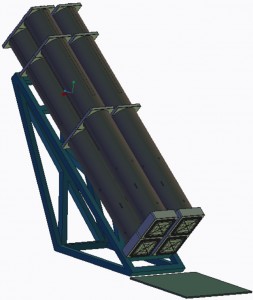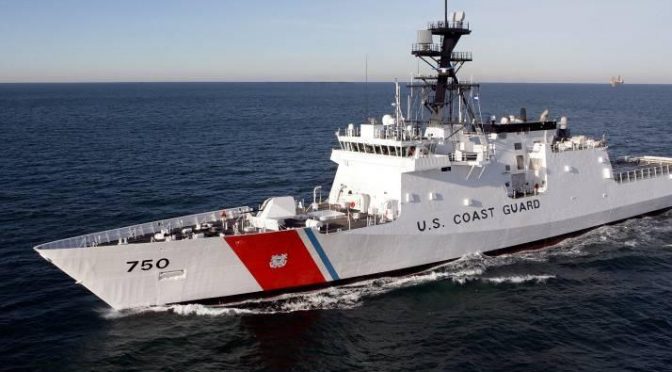By Chuck Hill
The Coast Guard has a problem. It is not currently equipped to perform one of its missions, and it appears no other agency is prepared to cover the deficiency. The Long Range Anti-Ship Missile (LRASM) may be a possible solution.
The Mission
One of the Coast Guard’s peacetime missions is Ports, Waterways and Coastal Security (PWCS).
“The PWCS mission entails the protection of the U.S. Maritime Domain and the U.S. Marine Transportation System (MTS)…prevention and disruption of terrorist attacks… Conducting PWCS deters terrorists from using or exploiting the MTS as a means for attacks on U.S. territory, population centers, vessels, critical infrastructure, and key resources.”
The Shortfall
Implicit in this mission is that the service should have the capability to forcibly stop a non-compliant ship, any ship, of any size. If a crew is motivated by simple greed, a .50 caliber machine gun is probably enough to convince them to take their chances in court rather than resist, but if the crew is motivated by a fanatical, or even suicidal belief in a cause, they become much harder to stop.
Terrorist targets are limited only by their imagination. They might include something like the Mumbai attack, an assault on a bridge, an LNG tanker or facility, a nuclear power plant, a passenger ship, an SSBN departing on patrol, or they might use a vessel to bring in a nuclear weapon.
The Coast Guard is an armed force at all times, but it is certainly not heavily armed. In fact, in terms of stopping a recalcitrant merchant ship, the Coast Guard seems relatively less capable now than they were eighty years ago.
This is because of the rapid growth in the size of merchant ships. Even the largest cutters with their 57 mm and 76 mm guns are far less capable of stopping today’s over 100,000 ton merchant vessels than the cutters of the 1930s, with their 5″ guns were against ships that were typically well under 10,000 tons.
Worse yet, the units that would actually be on scene to attempt to stop and board a ship suspected of being under the control of terrorists is unlikely to include any of the larger cutters because they seldom remain near harbor entrance. Rather, they are frequently sent well off shore.
The Coast Guard simply does not have the capability to deal with a terrorist attack using a medium to large sized merchant ship, and it currently appears that there is no other organization capable of answering this threat in the 30 or more port complexes terrorists might find worthwhile targets.
Our Friends
Navy surface forces, in U.S. waters, are too geographically concentrated. Navy ships tend to be either in homeport, working up in specific geographic areas, deployed, or in transit to deploy. There are no Navy surface warships homeported in the Gulf of Mexico, on the East Coast north of the New Port News/Norfolk complex, in Alaska, or on the West coast between San Diego and Puget Sound with weapons equal to or better than those on cutters. For many ports, the nearest Navy surface vessel is hundreds of miles away.
Air Force, Navy, Marine, and Army Air are not on standby around the U.S. armed with anti-ship weapons. Of the Air Force, only some strategic aircraft are training for the anti-shipping mission. Fighters and attack aircraft do not. The author suspects the U.S. would not get a timely response from the Air Force to a no notice requirement to stop a maritime target. Units that are not trained for an anti-shipping role cannot be easily pressed into that mission.
A Possible Solution
LRASM, with an over 200 nautical mile range and the ability to strike selected locations on a target ship, could possibly provide an answer. If the U.S. fielded LRASM on all nine National Security Cutters (NSC) and 25 Offshore Patrol Cutters (OPC) currently planned, its over 200 mile range could cover virtually all of these ports, and likely have a weapon on target within 20 minutes of launch.
[youtube https://www.youtube.com/watch?v=etb_Vzl-9Dk&w=560&h=315]
How It Might Work
The Coast Guard is developing a Maritime Domain Awareness system. Most likely, it will tap into the Navy’s system and over the horizon radars.
When the maritime domain awareness system detects the approach of a suspicious vessel, a small patrol vessel (WPB or WPC) is assigned to intercept it and conduct a boarding to determine the vessel’s nature and intent.
When the patrol vessel is assigned the intercept, a larger cutter that may be at some distance, but within range, would be directed to provide support in the form of a LRASM launch if necessary.
The patrol craft will transmit video, position, course, and speed during its approach which will allow the start of mission planning for an LRASM launch should it become necessary. The results of the patrol craft’s attempt to board will allow determination of hostile intent.
Once a determination of hostile intent has been made, and deadly force authorized, the supporting cutter can launch its weapon. The patrol craft will continually update the supporting cutter before and during the flight of the LRASM. Navy, Joint, and/or Allied procedures would be used to call for a strike, and should also work with other service’s assets if they are available.

Is It Affordable?
It is likely cutters could be equipped to carry eight missiles, but for peacetime purposes, two per ship would almost certainly meet the Coast Guard’s needs. Since some ships will always be in maintenance with ammunition removed, and others may be deployed where carrying the weapons would be counterproductive. The Coast Guard is unlikely to ever require more than about 50 missiles to meet its peacetime needs. A very rough estimate of LRASM unit cost would be something on the order of $2M to $5M each. That means the total cost of the missiles is likely between $100M and $250M. Adding launchers, control systems, and installations to cost would almost certainly be less than $500M. These costs would be spread over several years. This gives only an order of magnitude estimate, but it is several orders of magnitude less than the cost of other systems being deployed to protect the U.S. from attack.
Since the missiles, their launchers, and control systems are Navy type/Navy Owned equipment, the Navy would be responsible for paying for them. The cost of adding another four missiles per year for the Coast Guard to the Navy’s buy for LRASM could be lost in the rounding errors in the Navy budget.
For the Coast Guard, the program would probably require no more than 150 additional billets ashore and afloat. Not insignificant, but doable.
Conclusion
If the LRASM performs as advertised, its combination of range, warhead, and intelligent targeting may allow the Coast Guard’s small, but widely distributed force to effectively cover virtually the entire U.S. coast.
Chuck retired from the Coast Guard after 22 years service. Assignments included four ships, Rescue Coordination Center New Orleans, CG HQ, Fleet Training Group San Diego, Naval War College, and Maritime Defense Zone Pacific/Pacific Area Ops/Readiness/Plans. Along the way he became the first Coast Guard officer to complete the Tactical Action Officer (TAO) course and also completed the Naval Control of Shipping course. He has had a life-long interest in naval ships and history. Chuck writes for his blog, Chuck Hill’s CG blog.
Featured Image: USCG National Security Cutter BERTHOLF. Photo: U.S. Department of Homeland Security.


I don’t think the Coast Guard will ever have the C4ISR capabilities or the ROE to be employing missiles over the horizon.
Interesting idea. But, I’m smelling a lot of “if” coming off this proposal. If the threat were real, if the threat were detected in time, if the armed small boats or patrol craft can’t stop it, if intent were actually determined, if ROE approval were given, if some ship were able to sneak past the 72 hour notification requirement (moving at 25 kts).
Next, the author assumes one missile per bad-actor ship. First, things malfunction, so shoot two just in case. Second, if someone were determined enough to disrupt a port using a big ship, and it got to the point that a missile was needed, the bad actor probably has also installed some sort of CIWS to deter a missile threat; they are only limited by their imagination.
One other thing to ponder … CGC STRATTON gets ROE approval through the Commandant to launch, and does so; some Navy DDG doesn’t get the word, and only sees a missile launch from a surface target headed for CONUS, closes with and destroys the STRATTON with its own OTH missile battery. Hopefully the DDG gets there in time to pluck 110 Coast Guardsmen out of the chilly North Pacific.
Might work…of course the Navy needs frigates and the National Security Cutter fits the bill. STOP the current LCS/Frigate program and concentrate on the CG’s cutter. The LCS/FF’s could be transferred to the CG and armed as discussed in the article. To start the program USN personnel could be assigned to the cutters until there is enough Coasties.
Coast Guard cutters were armed with Harpoon in the Late ”80s/early ’90s.
Ih they will ever aprove, my bet is they will provide Harpoons to the USGC, considering they want to implement the LRASM in USN and they will have a lot of available, cheaper and useful Harpoons. Plus a lot of people trained to use them.